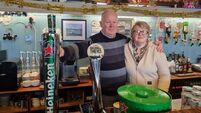Kowloon Bridge: Remembering the disaster that struck 30 years ago

Many lessons still need to be learned from the disaster on the high seas
Two miles off West Cork lies the remains of a buckled bulk carrier and a scattered cargo of iron ore pellets.
This week, 30 years ago, the disabled and abandoned 900ft long ship had the south-west in a grip of terror.
And, within days, the tourism and fishing region’s worst fears were realised as thick black working oil poured from the badly- fractured vessel.
At the time, it became the disaster.
And decades later, Irish legislation has not significantly improved to prevent a repeat of a catastrophe with huge ecological and environmental consequences as tonnes of bunker C oil initially gushed and continued to seep for several months afterwards.
Herring spawning grounds are still in recovery mode around the shipwreck on the Stag Rocks, a dramatic knife-edged formation just off Toe Head and Baltimore.
Seabirds perished despite mammoth efforts by local volunteers.
The cost to other marine wildlife was immeasurable.
However, no public inquiry was ever held.
Despite pledges by politicians, including then taoiseach Charles Haughey and ex-environmental minister Padraig Flynn, the ‘polluter will pay’, the country was not reimbursed.
Lloyds of London were the insurers of the ship registered in Hong Kong, while shareholders included global banks.
Cork County Council engaged its outdoor staff and the total cost, at the time, was £500,000.
The local authority had to bear the full cost. There had, of course, been unfulfilled promises of support from departments and ministers.
Several sister ships of the 1973-launched, built by Swan Hunter in the UK, sustained similar structural damage.
Unanswered questions remain if the ship which had crossed the Atlantic from Quebec was seaworthy.

Amid the complexities of salvage and clean-up operations and the impact on indigenous industries, an English scrap merchant Shaun Kent purchased the shipwreck for a single British pound.
Furthermore, environmentalists had fears uranium hexafluoride, a compound used in the uranium enrichment process that produces fuel for nuclear reactors and nuclear weapons, was being carried along with a large surplus of the anti-fouling paint tributyltin, known as TBT.
An exclusion zone of 1,000 metres around the ship was imposed in February 1997 by ministerial order.
Mr Kent, despite being the new owner, was not permitted to enter the zone at that time.
He remains the official owner of the mangled wreck and its then 160,000 tonnes of marble-sized iron ore pellets.
At the time, the ship had been insured for £8.7m and its cargo for £2.7m.
The iron ore which now surrounds the ship remains a precious trading commodity.
Mr Kent, for many years, remained committed to the recovery of the steel-built hull and also, possibly through a suctioning process, the recovery of the cargo.
He is within his rights to still proceed with what would be costly recovery operations.
However, interested stakeholders in marine-type food and tourism businesses along with environmental bodies would, most likely, challenge any planned measures to interfere with the seabed surrounding the wreck.

One of the sextet of sister ships, sank in 1980, initially without trace south of Japan during Typhoon Orchid with the loss of 44 lives, including two crew members’ wives.
At almost 92 gross tonne, she had been the largest British ship ever to have been lost at sea.
But in 1994, through efforts attributed to Mr Kent, the wreck was finally discovered spread over 1.5 km and at a depth of 4km.
Another ship, , had been sold for scrap in the 1980s after being abandoned in a storm.
The , meanwhile, had also been abandoned.
She had departed Sept-Îles bound for the River Clyde in Scotland.
In stormy conditions crossing the Atlantic, she sustained damage and headed for shelter in the deepwater 30km-long Bantry Bay.
Whiddy Island oil terminal, also in the bay, had at that time maintained the country’s strategic oil supply in its land-based tanks.
However, also at anchor and seeking shelter in Bantry was the Italian-registered , which had sustained damage in the same storm.
Anchored just a kilometre from the , the was carrying 80,000 tonnes of crude oil.
A Lloyds’ survey had found the sustained routine heavy weather damage and recommended the 170-tonnes combination carrier remain in Bantry Bay for temporary repairs.

However, on November 22, six days after its arrival, the anchor snapped and reportedly to avoid a potentially disastrous collision with the , the Indian officers decided to head out to the open sea.
In 50ft swells and winds topping 70mph, the ship was struggling and the master requested immediate assistance, reporting damage to the steering gear.
The on November 25 quoted a Turkish crew member as saying: “All hell broke loose around 11pm when most of the crew were asleep.
“The bow crashed down into the swell and did not come back up.”
Before midnight, its master gave the call to abandon ship and two RAF Sea King helicopters from the Royal Naval Air Station at Culdrose in Cornwall were tasked to complete a rescue of the 27 crew on board.
The LÉ Aoife continued to trail the heavily-illuminated, but disabled and abandoned, vessel before going to the assistance of a Spanish trawler.
On November 24, after narrowing missing hitting Cape Clear and Kedge Island, it grounded in heavy seas on the Stags.
Slight oil slicks had been observed immediately and on November 29, the Department of Communications issued a directive instructing the owners removed and dispose of the remaining oil.
Dutch salvage company Smith Tak International failed in attempts to shift the vessel off the rocks while gale force winds hampered plans to offload the oil, to tankers.

On December 3, the fractured started to go under.
The Government had threatened heavy penalties on the ship’s owners and demanded salvage operations should be resumed.
But then communications minister Jim Mitchell was forced to accept on December 12 that, due to atrocious conditions, every reasonable effort had been made to remove the wreck and oil.
Despite preventative measures, in the six months that followed, the thick oil seeped into dozens of inlets, beaches and rocky shores with varying degrees of damage.
Inshore fishermen had lost one of their key herring grounds while the tourism industry, confident of a recovery from a slump in the mid-1980s, had been buoyed by plans in early 1997 to recommence the Swansea-Cork Ferry service.
Fear and anger gripped the community, the concern being over the risk to crucial local industries and frustration at the inadequacies of the Government and legislation to prevent the ship leaving Bantry before its working oil had been offloaded.
The State’s Oil Pollution Operations Group, established in 1984, was activated for the first time and it implemented a national oil emergency plan. It directed council workers to try to safeguard Europe’s unique seawater-freshwater marine reserve at Lough Hyne, close to where the ship grounded.
The county council was given a lead role in a clean-up as experts criticised government inaction in delaying the removal of the oil.
Bantry-based environmental organisation Earthwatch, supported by a Kowloon Bridge Emergency Committee and wildlife groups, stepped up the pressure on the government and demanded a review of legislation, the impact on local industries, and called for a public inquiry.

On nearby Sherkin Island, Matt Murphy’s privately-run and independent marine station engaged international expert Dr Jenny Baker to assess the damage and the continuing risks.
In the reports and studies compiled by Sherkin Island Marine Station and Earthwatch, it was obvious both sides were on a different wavelength.
Earthwatch strongly suggested the marine station played down the scale of the disaster, while Sherkin Island founder Mr Murphy emphasised he was in the business of exaggeration.
Legislation
As a signatory to the International Convention on Oil Pollution Preparedness, Response and Co-operative Convention, Ireland is obliged to have a National Contingency Plan.
The plan includes search and rescue and saving lives at sea, along with marine pollution from ships, ports, harbours, and offshore installations.
The Sea Pollution Act 1991 makes provision for the prevention of pollution of the sea by oil and other substances.
In managing pollution, the aim is prevention, minimising, and mitigating the effects of any discharges.
Provision is also made for an at-sea response, harbour and shoreline response.
Pollution operations at sea include monitoring and satellite surveillance.
Breaches and resultant prosecutions are also catered for in the legislation.

With the Department of Transport, Tourism and Sport a key player, almost every state agency and department is involved from The Irish Coast Guard, Marine Casualty Investigation Board to the Commissioners of Irish Lights, Environment Protection Agency, and the Health Service Executive to departments of agriculture food and marine, defence, environment, justice and equality, and others.
Intervention procedures include salvage to remove pollution or the threat, removal or destruction of a vessel, orders to the master, owner or operator of a ship.
Legally, the Director of the Irish Coast Guard is designated as the competent authority with powers, for the purposes of European directives to take independent decisions concerning the accommodation of ships in need of assistance.
The Sea Pollution Act 1991, in the event of a marine casualty, has powers to intervene and direct shipping and those in charge of vessels or harbours to take, or refrain from taking, any action of any kind.
Cargo retrieval would be ‘war’ on environment
As a trading commodity, the iron ore cargo carried on the remains a valuable asset.

But the cargo, on a seabed 40m below the surface, is not easily accessible and is long discharged from the holds of the shipwreck.
The bulk of the iron ore is, however, still within the vicinity of the shipwreck, and reportedly visible, under a dusting of silt, with the ebb and flow of tidal actions.
The ore, in pellet form, has been valued at £2.7m in today’s markets, and the commodity trading, on average at $55 a tonne for much of this year, retains a strong value.
Recovery of some of the cargo is possible through suctioning or dredging, but not without impacting on the environment, and not without a likely public outcry.
“Any form of excavation of a seabed creates a war zone, environmentally,” said Baltimore-based businesswoman, Rianna Smith. “The damage would be indescribable.
“Dredging kills all kinds of marine life, including fish. It kills everything.”

She and husband, Jerry, run Aquaventures, in Baltimore, one of five local businesses which provide diving schools, whale- and dolphin-watching, and coastal eco tours.
The , Ms Smith said, is the biggest diveable wreck in the world, in terms of access.
“The attraction for a diver is being able to float around it, touch a piece of metal, explore what is now a new reef with losts of marine life.
“There’s a good growth of marine life around the wreck. It’s not ship-shape, by any means, but it’s incredible to see how huge beams and metal structures have been twisted by the ocean.
“It’s a graveyard down there.
“On really bad, stormy days, nature still manages to extract a blob of oil.
“Any salvage of the ship would have a huge impact on nature, the general environment, and the many businesses.
“This is Carbery’s One Hundred Isles, where there’s fish farms, mussel farms.
“Any suction or dredging of anything from the wreck would create a huge fall-out for the environment.
“It would also be devastating for marine-related and tourism businesses.
“With the Wild Atlantic Way giving a new impetus to tourism, marine tourism, in particular is a big growth business, with whale-watching, diving, snorkelling, and other activities, having great appeal to individuals and groups”.

Jerry and Rianna established a petition a number of years ago to highlight the environmental and marine threat of a salvage plan around the .
They wanted the Government to prevent any new salvage plan.
“Some people think when you drop something into the sea, you’ll find it intact and the same goes for shipwrecks.
“People don’t realise nature’s impact on such a huge, steel-built structure.
“About ten years ago, sonar systems were used to check out the spread of the cargo and wreckage.
“At the time, it had a huge effect on marine life, including dolphins.”

The petition, she said, died, as plans by the ship’s owner, Shaun Kent, and a reported Canadian enterprise, did not fully materialise.
Diver Louis narrowly avoided serious injury
Deep sea diver, Louis O’Leary, avoided serious injuries as he was setting up a drill for a hot-tap procedure, to suck out the oil on the submerged vessel.

It was a dangerous location to dive, he said, due to strong surges.
“There was a little lip, about an inch wide, along the edge of the ship and it was causing a surge,” said Mr O’Leary. “As I was setting up the drill, a surge took me straight over the ship and, as it did, it flipped my weight belt.
“I was wearing a dry suit, which was semi-inflated, and I just managed to grab the weight belt, before it fell to the seabed — otherwise, I would have floated to the surface.”
He escaped decompression, or the ‘bends’.
He had been engaged with Celtic Sea divers, examining the possibility of the vessel being towed off the rocks and, also, salvage company, Smith Tak, tasked with removing the 2,000 tonnes of working fuel oil.

The doors of the ship’s wells were open, he said, and water was bellowing in through hatches, creating a pump action. “It was frightening to get sucked in, but if you waited and didn’t panic, the pump action would blow you out again.”
He also aided owner, Shaun Kent, for several days, in removing anti-fouling paint.
“Any anti-fouling paint is poisonous to marine life and Mr Kent possibly believed he would find favour with local environmentalists, if it was removed,” said Mr O’Leary.
Having examined the ship for a department of marine structural engineer, Clonakilty-born Mr O’Leary said it was obvious, from first glance, that the ship was on its last legs.

“The ship was reportedly in trouble with its power, but the first thing I landed on was a huge generator, almost the size of a normal kitchen,” he said. “We were asked to check steering pipes, but the damage was extensive — it’s hard to say if they had been interfered with, but the damage looked as if a sledge hammer had been taken to them.”
Ex-fisherman, Colin Barnes, now a whale-watch expert, had observed the vessel drifting, the night before it grounded on the Stags.
“I was with the late Joe Barry and I remember saying: ‘You know where she’s going.’ We watched until 11pm and, at 5am, we went to Toe Head and there she was on the rocks, as expected. We went out at first light and, thinking it was going to sink within hours, Joe and another crewman jumped on board first.

“What amazed me, everything was so bloody big and it was obvious the crew had left in a hurry.
“We picked up a few bits, souvenirs. I recovered the compass, which I later gave to the captain, and a nice pair of binoculars, which were returned to me after a year and a day by the receiver [of wrecks].”
Differing accounts of environmental impact
Government’s lack of interest after spill ‘disappointing’
Furious at the disinterest by the government of the time, voluntary organisation arrived outside Dáil Éireann with 100 dead sea birds.

Mary Jordan, a leading light in the group, said: “Thousands of birds, covered in oil, had died and the impact on seals or other wildlife was immeasurable.
“After the initial drama of a disabled ship circling the sea and finally being grounded, the government and much of the media became disinterested, which was very disappointing.
“No department was prepared to accept responsibility for what was happening and no solutions had been forthcoming.
“The gardaí outside the Dáil were very shocked by the sight of dead oiled birds and kindly stopped many politicians in their cars as they emerged from Leinster House to give us an opportunity to hand out leaflets demanding action.
“I saw Jim Mitchell, the minister, take another exit and run to his office on the other side of the road.
“I ran after him with two dead guillemots, but I didn’t catch him.
“After the February election in 1987, Mr Haughey as Taoiseach arrived in Baltimore.
“Along with others, we had a meeting with him and he asked us what we wanted.
“We requested a department of marine be established and he agreed. We also demanded the remaining oil be removed.
“He set up the department but, unfortunately, in governments since, there has been no dedicated department of marine with it being attached to other departments.”

Care centres for injured birds had been set up at two locations, but just after the release of birds, wintered at Rory Jackson’s home at Toe Head and recovering from being oiled and cleaned, a major spill from the wreck immediately killed them.
Ms Jordan said council workers and scores of volunteers put in a super-human effort to clean beaches and bag oily sand.
She said many people in a fledgeling tourism industry were annoyed the disaster had been kept in the public eye in the early months of 1987 was negative publicity.
“It was a nightmare time on several fronts — there was the reality of seeing all the dead seals and birds, wildlife struggling for survival, covered in oil. No one knew when the oil leaks were going to stop.
“There were rumours about toxic materials on board along with the realisation an important spawning ground could be permanently damaged.
“In the meantime, people with B+Bs and other tourism interests wanted the negative publicity to stop.”
Station chief disputes ‘playing down’ extent of damage
Sherkin Island Marine Station, at its own expense, published three bulletins in January, March, and April of 1997, to assess the pollution damage, mainly at tourist locations, and put forward suggestions to have the shipwreck’s remaining oil removed.
Research director with the UK’s Field Studies Council, Jenny Baker, led the inspections and, at times, visited 58 locations along the west Cork shoreline.

At many sites where county council clean-ups had taken place, she found there were no obvious areas of serious shore pollution, but tar spots that would be a nuisance to tourists.
Wildlife and environmental groups such as Earthwatch strongly disagreed with some of the findings and they said that the marine station was ‘playing down the scale’ of the disaster.
Matt Murphy, 81, the founder of Sherkin Island Marine Station, who is still residing and running his station on Skerkin Island, said last week: “I wasn’t going to exaggerate, I still don’t believe in that.
“There were tales of West Cork beaches being destroyed at a time when people were making summertime plans to visit the region. There were horror stories being relayed.
“The pollution didn’t even reach Bantry. It was there in spots, but the damage, at the time, condemned the region to total pollution.
“At the time, Jenny Baker had two decades experience behind her in oil pollution research and responding to oil spoils from an ecological viewpoint. She had worked in Britain, Nigeria, Indonesia and South America in Panama and Chile.
“She offered recommendations about the clean-up and the necessity to remove the oil from the ship.
“I think if something like that ever happens again, I hope there will be extensive monitoring like the marine station did.
“Two years after the incident, there was hardly a trace of oil. Nature had completed the clean-up.”
However, Mr Murphy said the unsung heroes of the clean-up had been the county council outdoor staff.
“Under Ted Murphy (a now retired senior executive engineer in West Cork), the efforts by council staff stunned me at the time.
“On one occasion, they were on Ownahincha strand, with a south-east wind hammering them, and they were armed with small scrubbing brushes, cleaning rocks.
“They never got the credit they deserved.
“There were lots of people wanting to blame everyone. What more could they have done?
“They had plastic bags... brought them over the rocks on makeshift stretchers.
“Jenny Baker was, and remains, one of the most honourable people in the scientific world.
“There was no-one else at the time examining our rocky shores. After her third visit to West Cork to survey the shorelines, she said: ‘You’re seeing what I see’ indicating that by April there was little evidence of any pollution.
“If I had said that, I would have been accused by some of having an agenda.”

Mr Murphy said birds did not die on the beaches all over West Cork, as was strongly suggested.
“I never saw dead birds.”
He was accused, he said, of being a disgrace and losing the respect of environmentalists.
“I said to one person, ‘do you want me to lie?’ I’m wasn’t in the business of lying.
“I always stated the facts, in the 40 years I have been running the marine station, we keep to the facts I have never exaggerated”
“The grounding was a wake-up call of what could happened — I still believe a national grouping should meet every six months, at least, to revise plans and examine legislation for any major emergency.”














